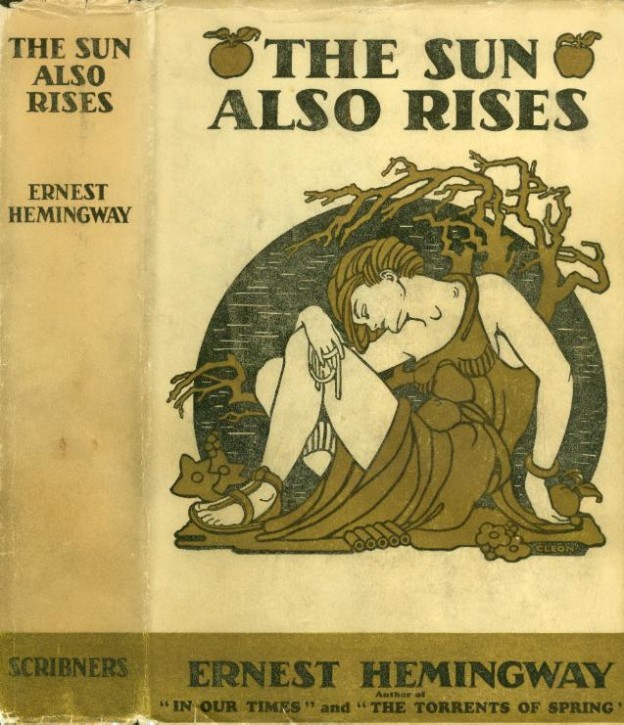If at this point in your life you have still not read The Sun Also Rises there’s no need to berate yourself. The great thing about great books you have not yet read is that you are in for a treat when you finally do get around to them. After all, if we had already consumed every iconic novel we might be awfully accomplished but it would also take away that magical frisson that comes from the first-time discovery of something really special.

The story and Jake’s crisis begin in Paris, where he falls in love with the shorthaired and vivacious Lady Brett Ashley, the embodiment of the newly liberated woman of the Jazz Age. Lady Brett in turn is loosely engaged to the often inebriated and often broke scion of a rich English family, Mike Campbell; pursued by the wealthy and insecure Jewish-American sort-of-writer Robert Cohn; and cannot help but seduce the handsome and athletic matador Pedro Romero once the group gets to Spain. All of Lady Brett’s actions create unbearable tension for Jake, coming to a head in Pamplona at the Festival of San Fermín, because while he loves her and she loves him to a degree, he has been made impotent by his war wounds and so cannot satisfy her. In the end Jake realizes that the games that these rich people play are not what he aspires to or respects. Even Lady Brett is not worthy of his admiration despite his feelings for her because, by seducing the young bullfighter Romero, she has sullied the one pure thing that Jake has found in his seemingly aimless post-war revelry, that of the artist doing his work well and skillfully. Only his visiting American friend and fellow veteran Bill Gorton seems worthy of true friendship despite his flaws by displaying a steadfastness and love of nature equal to Jake’s when they take an idyllic fishing trip together prior rejoining the antic group in Pamplona.
Throughout Sun Also Rises, Hemingway displays the preternatural storytelling skills that would make him America’s most famous and acclaimed writer. Keeping in mind that he was 27 years old and had only written short stories prior to its publication in 1926, albeit excellent ones, the novel comes as a revelation. While it is made up of three Books — essentially Paris, Pamplona and Aftermath — there is a clear through line and narrative arc that keeps the Books from becoming disconnected or fragmented, as a stitched together series of vignettes might be. And by deploying his now archetypal spare prose and lack of extraneous narration, the reader becomes a co-participant in the mental cinema of the events, filling in and coloring those “off-screen” events that were deliberately omitted (aka the “Iceberg theory”). This is really Hemingway’s genius as a writer: If F. Scott Fitzgerald wrote the most beautiful and hauntingly filigreed sentences in American literature, Hemingway wrote the most potently direct and stripped down for sublime and subliminal effect.
As always with Hemingway, the vividly drawn characters are augmented by the crisp and passionate descriptions of the natural world with a real feeling for the “vibe” of the different locations and the sensual joy of good food and drink and music. The reason why Hemingway still resonates today is that his style is indelibly modern and not prone to showing its years (with the exception of some unfortunate casual racism at times, although some of this is deliberate character exposition). You feel that you are in the world he is describing, that you can smell and taste it, that you can feel the excitement of the running of the bulls and the bullfight and the dancing and the smell of the crowded festival and the sweet wet wine from the wineskin in your mouth and dribbling down your chin. And you feel the ebb and flow of human relations, their excitement and despondency and disappointment and redemption and the pettiness and beauty that is humankind. The fact that the characters in the novel are only thinly veiled fictional versions of real acquaintances only adds another dimension to the story when one delves further into the author’s biography. In short, The Sun Also Rises is the book that launched Hemingway’s career as a novelist and that many still consider his best work. We’re not so sure about that — how do you choose which is the “best” Cézanne? But we do know that whether it’s your first or fiftieth time reading it, you’re invariably the better man for having done so. It can teach you about art, about writing, about honor and about manhood, however you choose to interpret those concepts. Best of all, reading Sun should invariably lead you to want to read more Hemingway. And since nearly all of what Papa wrote is worth reading, that may be his first novel’s greatest gift: as gateway to the works of one of the undisputed masters of 20th century literature.


